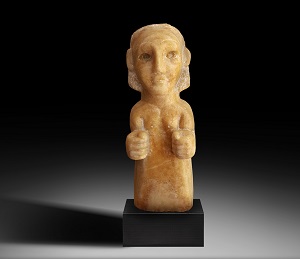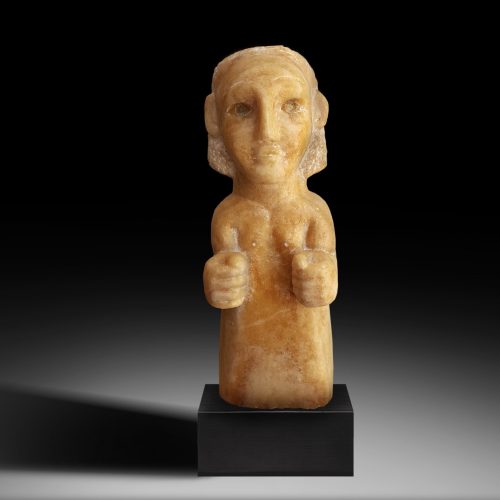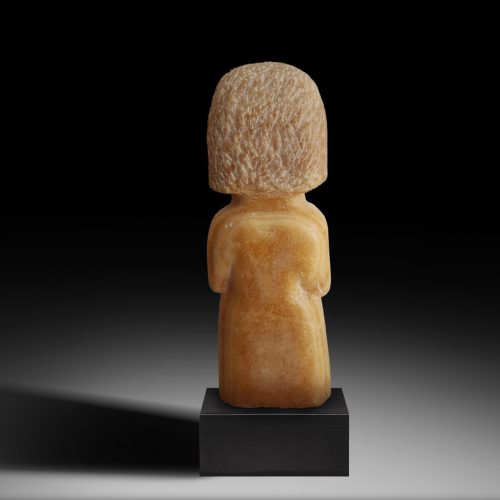PERIOD | Circa 3rd Century BC to 1st Century AD |
|---|
ORIGIN | Possibly Qataban |
|---|
DIMENSIONS: | Height:30.5 cm |
|---|
DESCRIPTION: | A magnificent calcite female figure, displaying the stylised and elegant forms unique to South Arabian art. The figure is standing with extended arms and clenched fists, the sensitively carved face exudes power and mystery, with large, almond-shaped eyes, sweeping eyebrows, a straight nose, and gently smiling lips.The South Arabian kingdom of Qataban rose to prominence in the fourth century BC. Its capital Timna was an important stop along the incense trade route, thanks to which it became an extremely prosperous and sophisticated economic and cultural centre. The style of the present figure suggests it comes from Haid bin Aqil, Timna’s necropolis, where some of the greatest treasures of South Arabian art have been discovered. Qatabanian artists were greatly skilled, and their sculptural production is noted for its delicacy and quality. Their strikingly modern forms fascinated and inspired some of the most important artists of the early twentieth century, such as Pablo Picasso and Amedeo Modigliani.Complete figures of this type with an original surface and documented provenance are very seldom encountered on the art market; a superb piece of ancient sculpture. |
|---|
FOOTNOTES: | The most remarkable artworks aside from architecture from pre-Islamic South Arabia are sculptures. In addition to bronze (and occasionally gold and silver), limestone was a common material for sculptures, especially alabaster and marble. Typical features of ancient South Arabian sculpture are cubic base forms, a plump overall shape and a very strong emphasis on the head. The rest of the body is often depicted only in a schematic and reduced fashion; often only the upper body is depicted at all. Much South Arabian art is characterised by minimal attention to realistic proportion, which manifests with large ears and a long, narrow nose. In most cases, sculpture in the round and reliefs faced directly at the viewer; in reliefs the frontal perspective is typical of Ancient Egyptian Art, in which the head and legs are depicted from the side, but the torso from the front, is occasionally encountered. Pupils were made of coloured material which was inserted into holes in the eyes. Initially, drapery was not depicted, but later it was indicated by deep grooves or layers. There are no general characteristics in the arrangement of arms and legs. |
|---|
PROVENANCE: | From Private collection, by descent to the present owner |
|---|
CERTIFICATE: | Comes with a certificate from the Art Loss Register. |
|---|







